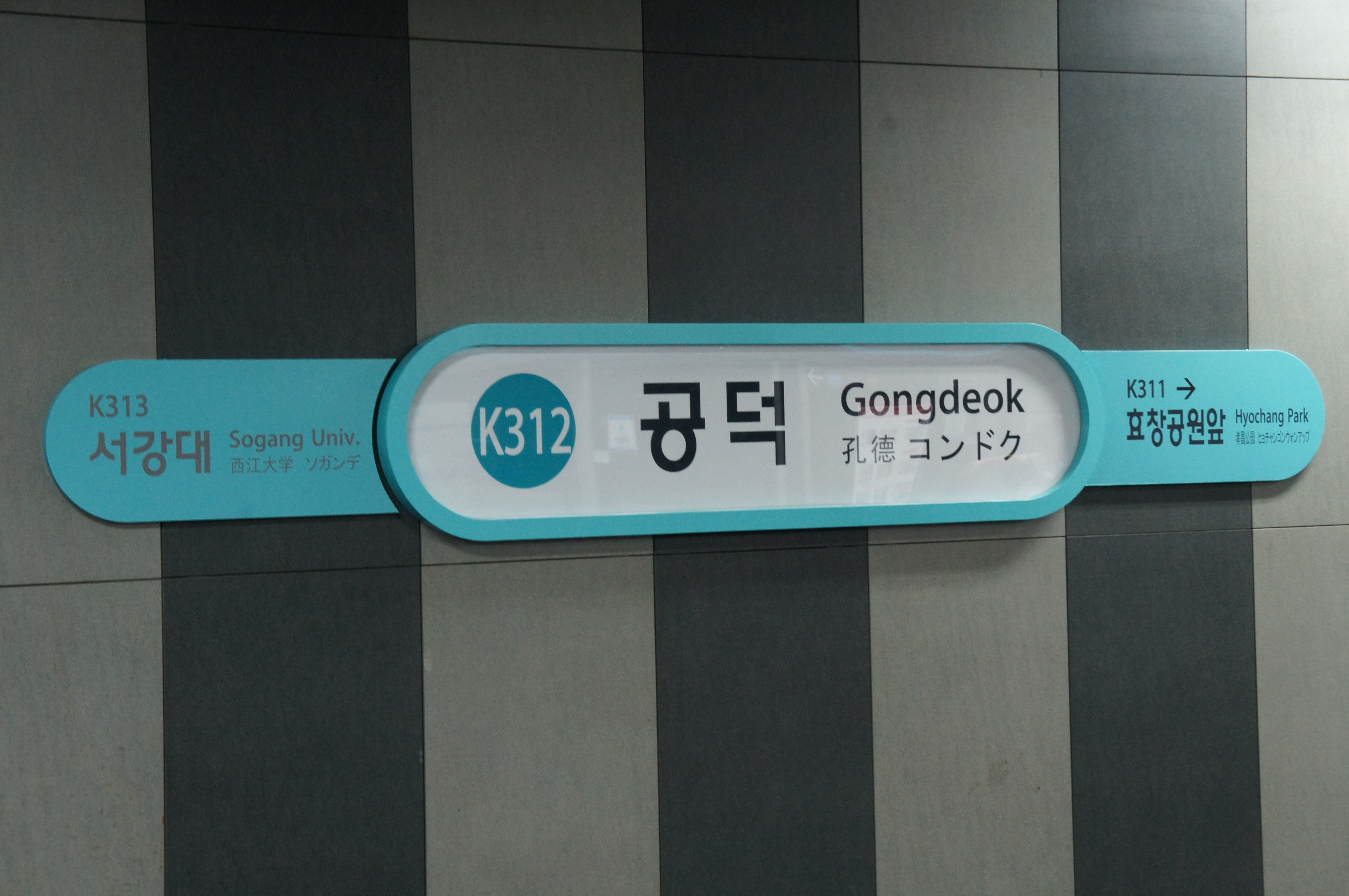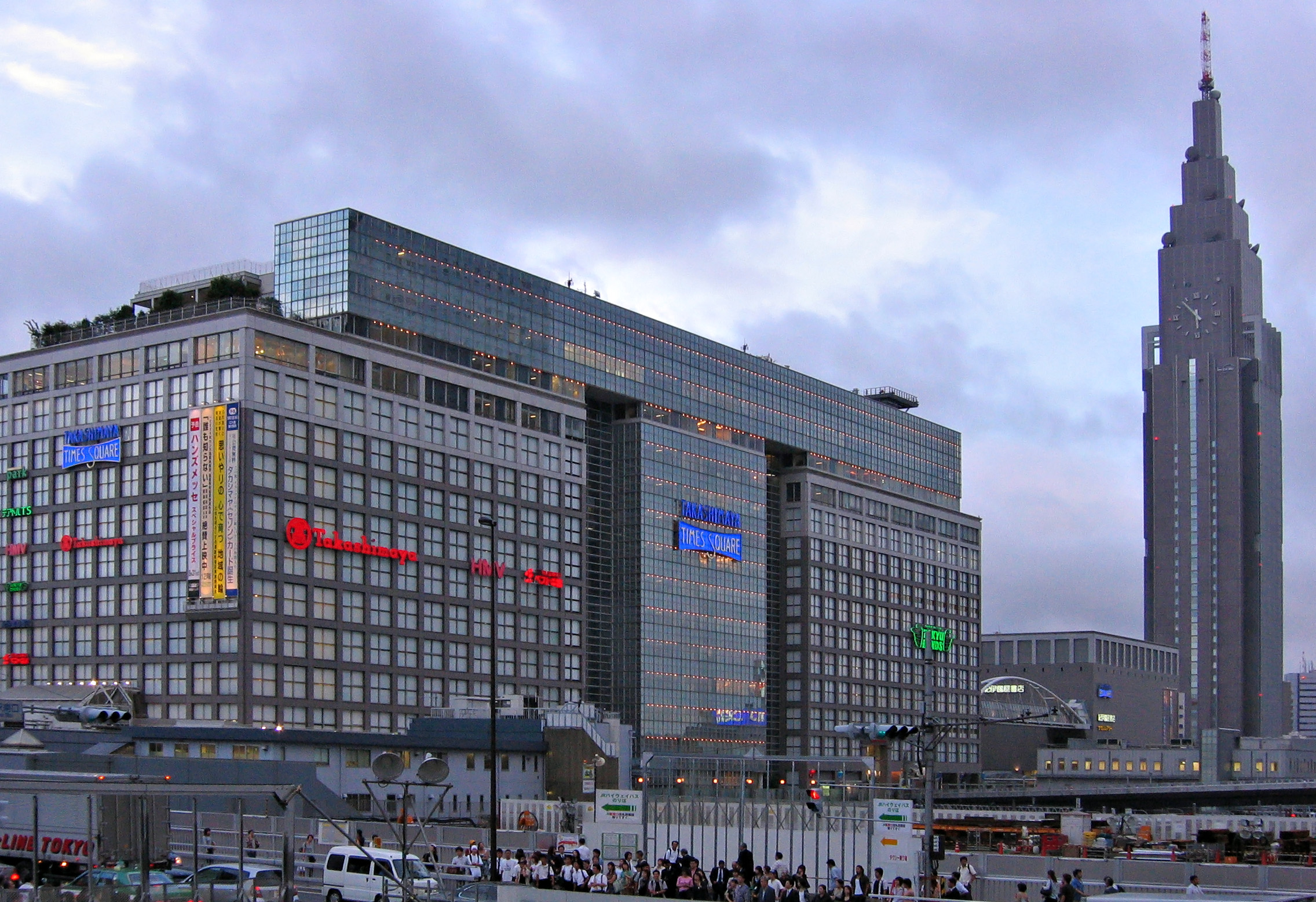|
Seibu-Shinjuku Station
is a railway station in Shinjuku, Tokyo, Japan, operated by the private railway operator Seibu Railway. It is the terminus of the 47.5 km (30 mile) Seibu Shinjuku Line, which extends to in Saitama Prefecture. The station is located approximately 420 meters (460 yards) by foot from Shinjuku Station. It is part of the Shinjuku Prince Hotel and Seibu Shinjuku PePe shopping complex, with the ticket machines and platforms located on the second-floor level. The main entrance is located at the southern end, and a smaller "North entrance" is located at the north end of the station. Platforms The station has three elevated platforms serving three tracks. Platform 1 is normally used for all-stations "Local" services, platform 2 is normally used for "Limited express" and "Rapid express" services, and platform 3 is normally used for "Rapid", "Express", and "Semi express" services. File:Seibu-Shinjuku Station North exit 20110319.jpg, North exit, March 2011 File:Seibu-Shinjuku_Stati ... [...More Info...] [...Related Items...] OR: [Wikipedia] [Google] [Baidu] |
Shinjuku, Tokyo
is a special ward in Tokyo, Japan. It is a major commercial and administrative centre, housing the northern half of the busiest railway station in the world ( Shinjuku Station) and the Tokyo Metropolitan Government Building, the administration centre for the government of Tokyo. As of 2018, the ward has an estimated population of 346,235, and a population density of 18,232 people per km2. The total area is 18.23 km2. Since the end of the Second World War, Shinjuku has been a major secondary center of Tokyo ( ''fukutoshin''), rivaling to the original city center in Marunouchi and Ginza. It literally means "New Inn Ward". Shinjuku is also commonly used to refer to the entire area surrounding Shinjuku Station. The southern half of this area and of the station in fact belong to Yoyogi and Sendagaya districts of the neighboring Shibuya ward. Geography Shinjuku is surrounded by Chiyoda to the east; Bunkyo and Toshima to the north; Nakano to the west, and Shibuya and ... [...More Info...] [...Related Items...] OR: [Wikipedia] [Google] [Baidu] |
Station Numbering
Station numbering is a sign system which assigns station codes consisting of a few letters and numbers to train stations. It aims to facilitate navigation for foreign travelers not familiar with the local language by using globally understood characters (Latin letters and Arabic numbers). The system is now in use by various railway companies around the world such as in Mainland China, Indonesia, Japan, South Korea, Singapore, Taiwan, Thailand, and the United States. History Station numbering first introduced—but to less fanfare—in South Korea, by the Seoul Metropolitan Subway in 1983 as a section of Seoul Subway Line 2 ( Euljiro 1-ga to Seongsu) was opened. Its first usage in Japan was in the Nagasaki Electric Tramway where it was introduced in May 1984."History of Nagasaki Electric Tramway line transition", ''Stadtbahn'' issue 9, April 1984 The Tokyo subway system introduced station numbering in 2004. Sports events are usually the turning point for the introduction of s ... [...More Info...] [...Related Items...] OR: [Wikipedia] [Google] [Baidu] |
Railway Stations In Tokyo
Rail transport (also known as train transport) is a means of transport that transfers passengers and goods on wheeled vehicles running on rails, which are incorporated in tracks. In contrast to road transport, where the vehicles run on a prepared flat surface, rail vehicles ( rolling stock) are directionally guided by the tracks on which they run. Tracks usually consist of steel rails, installed on sleepers (ties) set in ballast, on which the rolling stock, usually fitted with metal wheels, moves. Other variations are also possible, such as "slab track", in which the rails are fastened to a concrete foundation resting on a prepared subsurface. Rolling stock in a rail transport system generally encounters lower frictional resistance than rubber-tyred road vehicles, so passenger and freight cars (carriages and wagons) can be coupled into longer trains. The operation is carried out by a railway company, providing transport between train stations or freight customer fac ... [...More Info...] [...Related Items...] OR: [Wikipedia] [Google] [Baidu] |
Toei Oedo Line owned and managed by the Bureau of Urban Development, Tokyo Metropolitan Government
{{disambig ...
Toei or Tōei may refer to: * Tōei, Aichi, Japan * Toei Company, Japanese film and television production company ** Toei Animation, their animation subsidiary * , Japanese abbreviation meaning "operated by the Tokyo Metropolitan Government" **Transportation lines operated by the Tokyo Metropolitan Bureau of Transportation (TMBT) *** Toei Subway (都営地下鉄) *** Toei Bus (都営バス) ** Toei Jūtaku (都営住宅), public housing Public housing is a form of housing tenure in which the property is usually owned by a government authority, either central or local. Although the common goal of public housing is to provide affordable housing, the details, terminology, def ... [...More Info...] [...Related Items...] OR: [Wikipedia] [Google] [Baidu] |
Hanazono Shrine
The is a Shinto shrine located in Shinjuku, Tokyo, Japan. This shrine was founded in the mid-17th century. Hanazono Jinja nestled in the heart of Tokyo's Shinjuku ward, Hanazono Jinja is a small and unobtrusive structure that, according to Fodor's, just happens to be one of the most historical shrines in Japan. Constructed in the Edo period by the Hanazono family, this Inari shrine—a shrine dedicated to Inari, the androgynous god of fertility and worldly success—is a favorite place for businessmen to pray for successful ventures. History Hanazono Shrine was originally founded before the start of the Edo period, about 250 meters south of its present-day location. In the Kan'ei era, the shrine was relocated to the gardens of the Owari-Tokugawa family, in an area that had until then been a prolific flower garden, to make space for the villa of a shogun’s vassal. Before the Meiji period, a branch temple of a Shingon Buddhism sect was enshrined with Hanazono’s Shinto shrine, an ... [...More Info...] [...Related Items...] OR: [Wikipedia] [Google] [Baidu] |
Shinjuku Golden Gai
is a small area, which is located in Kabukicho, Shinjuku, Tokyo, Japan. It is composed of a network of six narrow alleys, connected by even narrower passageways which are about wide enough for a single person to pass through. Over 200 tiny shanty-style bars, clubs and eateries are squeezed into this area. The alleys are private roads, not public roads. In this area, shooting photographs and video for all purposes on the street is prohibited without permission of the area's business promotion association. Streetscape Golden Gai is a few minutes' walk from the East Exit of Shinjuku Station, between the Shinjuku City Office and the Hanazono Shrine."Golden Gai" ''Unmissable Tokyo .com''. Retrieved June 14, 2010. Its architectural importance is that it provides a view into the relatively recent past of Tokyo, when large parts of the city re ... [...More Info...] [...Related Items...] OR: [Wikipedia] [Google] [Baidu] |
Takashimaya
is a Japanese multinational corporation operating a department store chain carrying a wide array of products, ranging from wedding dresses and other apparel to electronics and flatware. It has more than 12 branches strategically located in 2 regions, and 4 international branches around Asia. Takashimaya has been a member of the International Association of Department Stores from 1962 to 1997. Takashimaya was listed at #1197 on the Forbes Global 2000 list for 2006. Takashimaya is a member of the Sanwa Group keiretsu. History The first Takashimaya store was opened in Kyoto in 1831 as a sole proprietorship owned by Shinshichi Iida, a merchant from present-day Fukui Prefecture. The original store in Kyoto was only 3.6 square meters in area and specialized in selling gofuku (formal kimono). A second Kyoto store opened in 1893, followed by a Tokyo store in 1897 and an Osaka store in 1898. Takashimaya was incorporated as a gomei kaisha (unlimited liability company) in 1909 and ... [...More Info...] [...Related Items...] OR: [Wikipedia] [Google] [Baidu] |
Seibu Railway
is a conglomerate based in Tokorozawa, Saitama, Japan, with principal business areas in railways, tourism, and real estate. Seibu Railway's operations are concentrated in northwest Tokyo and Saitama Prefecture; the name "Seibu" is an abbreviation of "west Musashi", referring to the historic name for this area. It and its holding company hold shares of numerous bus, hotel and tourism operations nationwide. History "Seibu Railway" was originally the name of a tram service between Shinjuku and Ogikubo, which was transferred to the Tokyo metropolitan government in 1951 and eventually closed in 1962. The Seibu Railway was acquired in 1921 by the Kawagoe Railway, which had operated a train service between Kokubunji and Kawagoe since 1894; the merged company kept the "Seibu" name and expanded its main line to Takadanobaba, forming what is now known as the Seibu Shinjuku Line. The current Seibu Railway is a product of a 1945 merger between the former Seibu Railway and the Musashino ... [...More Info...] [...Related Items...] OR: [Wikipedia] [Google] [Baidu] |
Takadanobaba Station
is a railway station in the Takadanobaba area of Tokyo's Shinjuku ward, situated between the commercial districts of Ikebukuro and Shinjuku. The station is a major commuting hub, linking the Seibu Shinjuku Line, Tokyo Metro Tōzai Line and Yamanote Line. It also serves the surrounding Takadanobaba area, known as a popular student district, and is linked by bus to nearby Waseda University. It is the busiest station on the Seibu Shinjuku Line, and the second-busiest in the Seibu Railway network after Ikebukuro Station. It is the ninth-busiest station in the Tokyo Metro network and the eleventh-busiest station in the JR East network. Lines Takadanobaba Station is served by the following lines: * East Japan Railway Company (JR East) ** Yamanote Line *Seibu Railway ** Seibu Shinjuku Line *Tokyo Metro **Tokyo Metro Tōzai Line Station layout Platforms Yamanote and Seibu Shinjuku Line The Yamanote Line island platform and two Seibu Shinjuku Line platforms are located parallel to ea ... [...More Info...] [...Related Items...] OR: [Wikipedia] [Google] [Baidu] |
Prince Hotels
The is the name of a hotel chain company headquartered in Toshima-ku, Tokyo, Japan. It is a subsidiary of Seibu Holdings, Inc. Together with Seibu Railway, Prince Hotels is the core company of Seibu Group. Overview During the Allied occupation of Japan following World War II, many members of the Japanese peerage lost their titles and were subject to crippling taxation on their real estate holdings. Yasujirō Tsutsumi, who controlled the Seibu Railway through the Kokudo Corporation, arranged to buy several of these families' properties at a discount and used them to develop hotels. The first of these hotels, the Grand Prince Hotel Takanawa, opened in 1953 on the site of the Takeda-no-miya residence. The Tokyo Prince Hotel opened in 1964 on a site that originally housed graves of several Tokugawa family shoguns, whose bodies were moved to the neighboring temple of Zojo-ji. Originally, hotels branded as ''Prince Hotels'' were not wholly owned by Prince Hotels Company, but were ... [...More Info...] [...Related Items...] OR: [Wikipedia] [Google] [Baidu] |



.jpg)

